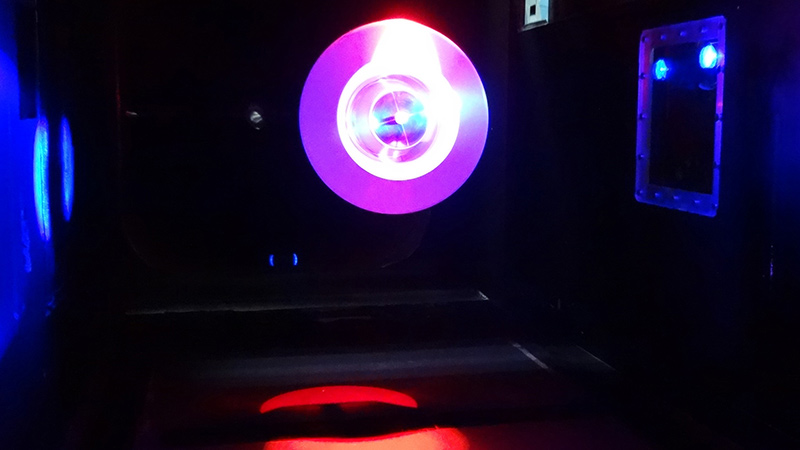Stay Up to Date
Submit your email address to receive the latest industry and Aerospace America news.
The Aerodynamic Measurement Technology Technical Committee advances measurement technology for ground facilities and aircraft in flight.
In a series of tests from January to March, MetroLaser of California demonstrated nearly instantaneous volumetric imaging of density in a turbulent jet using laser Rayleigh scattering. The technique is expected to enable detailed investigations of variable density flows that will advance the development of laser-based communications and weapons systems in which a light beam must propagate through a turbulent compressible flow field. Developed under U.S. Air Force funding, the method involves a rapidly spinning polygonal mirror that sweeps a pulsed laser sheet across the flow region of interest while a fast multiframe camera that is synchronized with the laser acquires images of Rayleigh-scattered light.
Instantaneous two-dimensional density distributions were produced in March, separated in time by 1.3 microseconds and in space by about 1 millimeter, forming a stack of images that comprise a three-dimensional rendering of the flow density. The density structure of a Mach 1.4 turbulent jet was analyzed, revealing flow features such as shock cells by essentially freezing them in time. Averaged volumetric density images were also obtained that offered more extensive coverage of the flow field. The knowledge of the instantaneous volumetric density field is critical for a priori determination of optical aberration that a laser beam suffers as it transits through such a flow field. MetroLaser in October was awarded a $750,000 contract from the Air Force to develop the technique for larger instantaneous flow field coverage.
The HORIZON (High-Speed Original Research and Innovation Zone) research group at the University of Tennessee Space Institute continued research on the characterization of unsteady transitional shock wave/boundary layer interactions, or XSWBLI. The group has developed a robust post-processing algorithm to identify shock positions in large sets of high-speed schlieren images, and in April demonstrated that the technique compares favorably to similar measurements made with surface pressure sensors. Power spectra calculated from these high-speed schlieren images of XSWBLI have suggested that the unsteady shock motion may be caused by unsteadiness in the separated flow region just upstream of the shock generator.
The group continued to refine a process for applying fast pressure-sensitive paint for the study of XSWBLI dynamics, following promising results of a demonstration as reported in a paper presented at the 2017 AIAA Aviation Forum. The work, sponsored by the Office of Naval Research, is ongoing and progress will be reported at upcoming conferences. HORIZON also made progress toward completing the new 24-by-24-inch TALon Mach 4 Ludwieg Tube facility for a planned operational date before the end of 2017.
JAXA, the Japan Aerospace Exploration Agency, in February used a magnetic suspension balance system, or MSBS, to measure a dynamic stability derivative of a Viking-type Mars entry capsule. The MSBS eliminates interference due to physical model supports, which is much larger in such dynamic tests as the support also moves with the model. A ballistic range has been commonly used for the capsule in order to avoid the interference in spite of low reproducibility of the model motion. JAXA succeeded in achieving an uncertainty of 20 percent for the pitch stability derivative measurement by the MSBS, practically halving those of 33 to 300 percent in the past ballistic tests. This was accomplished by rotating the model 90 degrees axially and forcing pitch oscillation horizontally, enabling model motions to be precisely controlled without vertical movement of center of gravity and highly reproducible.
Contributors: Christopher Combs and Hiroki Sugiura Thomas P. Jenkins is vice president of technology at MetroLaser. David H. Plemmons is a senior scientist with the National Aerospace Alliance at the Arnold Engineering Development Complex. Christopher Combs is a research assistant professor in the HORIZON Group at the University of Tennessee Space Institute. Hiroki Sugiura is an associate senior researcher at JAXA, the Japan Aerospace Exploration Agency.
Related Posts
Stay Up to Date
Submit your email address to receive the latest industry and Aerospace America news.




